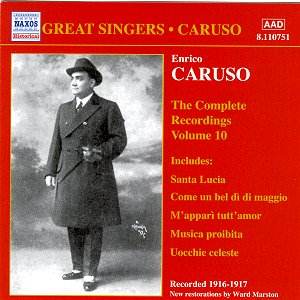Gabriel FAURÉ
(1875-1947)
‘Sancta Maria’
CARUSO
‘Tiempo antico’
Folk Song,
‘Santa Lucia’
Piotr Ilyich TCHAIKOVSKY
(1840-1893)
Eugene Onegin, ‘Pour moi
ce jour est tout mystère’ (Lensky’s
Aria).
‘Pourquoi’
Umberto GIORDANO
(1867-1948)
Andrea Chenier, ‘
Come un bel di maggio’
Camille SAINT-SAENS
(1835-1921)
Samson et Dalila, ‘Vois
ma misère , hélas'
Georges BIZET
(1838-1870)
Les Pecheurs de perles,
‘Je crois entendre encore’
Giuseppe VERDI
(1813-1901)
Rigoletto, ‘Bella
figlia del’amore’ (quartet)
Gaetano DONIZETTI
(1797-1868)
Lucia di Lamermoor, ‘Chi
mi frena in tal momento’ (sextet)
Friedrich von
FLOTOW (1812-1883)
Martha, ‘M’appari’
GASTALDON
‘Musica probita’
DE CRESCENZO
‘Uocchie celeste’
Francesco Poalo
TOSTI (1846-1916)
‘L’alba separa dalla luce l’ombra’
Anton RUBINSTEIN
(1830-1894)
Néron, ‘Ah! Lumiére
du jour’
As Hugh Griffith points
out in his sleeve note to Vol. 9, reviewed
elsewhere on this site, Caruso had
by 1916 recorded all the major tenor
arias, duets, etc. from the operas in
his stage repertoire as well as others
that suited his voice. Needless to say
he himself, and his record company,
Victor, were eager to meet public demand
for discs by the great tenor and more
varied repertoire was explored. This
collection includes several such items,
particularly the Tchaikovsky (trs. 4
and 5), sung in French, a language in
which Caruso was comfortable. Even without
knowing these works were outside the
singer’s normal repertoire, one senses
a lack of involvement, even a sameness;
a feeling that also pervades the Fauré
item (tr. 1). Whilst Caruso had prepared
Bizet’s ‘Les Pecheurs de Perles’ for
the Met in 1916 it was not a success.
Here, singing a semitone down, he sounds
too heavy for the part (tr. 9), particularly
when compared with his 1904 recording,
in Italian, which features in Vol. 2.
The singer’s timbre, and weight of tone
are far better suited to Samson’s aria
from ‘Samson et Dalila’ (tr. 8).
Elsewhere, this issue
presents songs by Caruso’s fellow Italians.
These he clearly relishes (trs. 16-19).
There is also a ‘take’ (tr. 20) of the
Rubinstein never issued on a 78 disc.
This opportunity to hear an alternative
‘take’ is repeated with the famous sextet
from ‘Lucia’ (tr. 13). Frankly the difference
from the published version is not audible.
What is eminently listenable is the
quality of the singing. This was Caruso’s
third recording of the piece, Victor
wishing to partner him with the best
of each period. Here they do so with
a vengeance; quite magnificent! The
same can be said of the quartet from
‘Rigoletto’ (tr. 11) Caruso’s fourth
recording, this time featuring the new
star sensation Amelita Galli-Curci,
as well as the great de Luca and Marcel
Journet. Interestingly track 12 gives
an alternate ‘take’ of the introduction,
ending abruptly at the entrance of the
mezzo. There Caruso’s tone is distinctly
lighter than in complete piece; interesting.
A few days before the
third recording session included on
this disc, 25 January 1917, America
entered World War I. Travel to Europe,
and home, was out for Caruso. He had
taken a voluntary break in 1916, feeling
the pressure of a punishing schedule,
but went back to South America in the
summer of 1917. Whether this resumption
of a hectic schedule hastened the crisis
of 1920 must remain conjecture. Certainly
in the Italian pieces on this disc he
is in glorious voice, with the high
B flat of ‘M’Appari’ (tr. 15) particularly
fine. The sleeve-note states that all
the items except the two alternate ‘takes’
have been transferred from ‘master pressings’.
I have not noticed that statement before
in this series and certainly the sound
is most impressive. This disc further
enhances Ward Marston’s reputation for
fine restorations in the Caruso series:
‘the tenor who made the gramophone’.
Highly recommended.
Robert J Farr

![]() Caruso accompanied by the ‘Victor Orchestra’.
cond. Walter B Rogers and Josef Pasternack
Caruso accompanied by the ‘Victor Orchestra’.
cond. Walter B Rogers and Josef Pasternack ![]() NAXOS HISTORICAL 8.110751 [76.59]
NAXOS HISTORICAL 8.110751 [76.59]